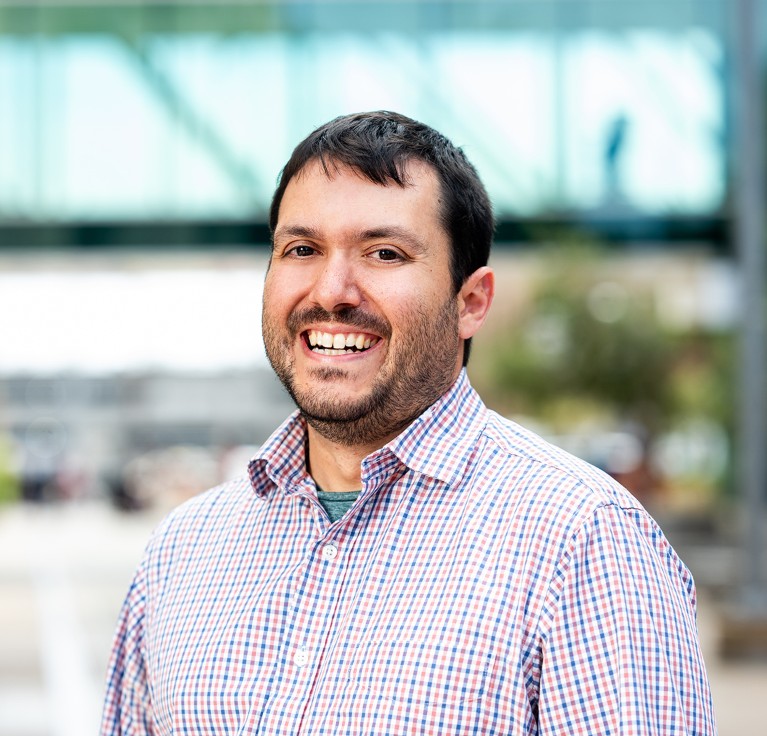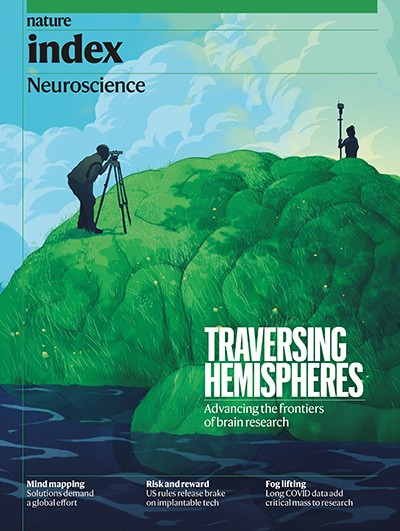Neurocognitive symptoms, including an impaired ability to process and memorize information, are among the most common and debilitating manifestations of long COVID, a disease experienced by as many as 400 million people worldwide, by one recent estimate (Z. Al-Aly et al. Nature Med. 30, 2148–2164; 2024). These symptoms, which can develop alongside those resulting from diseases of the lungs, heart and other organs, affect patients’ everyday functioning for months or even years following COVID-19. Matthew Fitzgerald, a 28-year-old former engineer at Tesla, described his long-COVID-related impairment during a clinic visit: “I’m a shell of myself. My physical issues aren’t half as bad as my brain problems. You can say brain fog, but that doesn’t come close to doing it justice.”
Nature Index 2024 Neuroscience
Extreme cases of long COVID stand out — authors who cannot write; nurses who fear making a medical error — but symptoms for most people are more insidious. Many long-COVID patients have neurological problems that meet the criteria for what would normally be considered age-related mild cognitive impairment, or mild to moderate dementia.
Over the past 30 years, US$42.5 billion have been spent on Alzheimer’s research, with limited progress. A decade ago, in part owing to the discovery of neurocognitive symptoms among younger, previously healthy people with complex illness in the intensive care unit, the US National Institutes of Health (NIH) designated a category known as Alzheimer’s disease and related dementias (ADRD) to describe neurological conditions that rob people of their memory and personhood. There is now ample evidence that both older and younger people with long COVID and other infection-associated chronic conditions are at risk of developing ADRD.

Michael J. PelusoCredit: Noah Berger/UCSF
As a result, the NIH and other institutions around the world have begun to expand the scope of dementia research to include long COVID under the funding umbrella of ADRD. We serve as co-investigators on a soon-to-launch National Institute on Aging-funded phase III trial to test whether baricitinib, an immune-modulating medication, can improve symptoms of patients with ADRD from long COVID. We hope that this and similar work will open the door for studies of other infection-associated chronic conditions, including myalgic encephalomyelitis/chronic fatigue syndrome and post-treatment Lyme disease.
Brain studies of COVID patients have been among the most revealing science to emerge from the pandemic. Patient scans reveal structural changes, such as in regions near the olfactory tracts and in specific areas of the blood–brain barrier, a membrane that protects the central nervous system from blood-borne toxins and pathogens. Signs of inflammation are sometimes present, and viral remnants have been found in brain specimens of people who died.

E. Wesley ElyCredit: Heidi Ross
Much remains unknown about how long COVID develops and can be treated, but research on the interplay between our immune and nervous systems could provide clues. Scientists have identified how vagal neurons, which connect the brain to the rest of the body, can relay information about pathogens to the brain stem by increasing or dampening the immune response, for example (H. Jin et al. Nature 630, 695–703; 2024). Many researchers have hypothesized that abnormalities in vagal signalling, potentially set off by the SARS-CoV-2 virus, can drive long COVID.
Considering that long COVID affects more than 5% of people infected with SARS-CoV-2, and the risk that some of these patients will develop a rapidly acquired ADRD, there now exists a critical mass of people to study in this category. Vast resources will be needed to untangle how SARS-CoV-2 infection causes long COVID and how it might be prevented and treated. This line of research could have major implications for autoimmune diseases, in general, and neuro-inflammatory conditions, in particular.
Funding organizations are beginning to respond. Beyond the NIH’s US$1.15 billion RECOVER initiative to support long-COVID research, institutes within the NIH are increasingly supporting studies of neurologic long COVID. Major funders in Europe and elsewhere are also stepping up. But more commitments are urgently needed. With sustained investment in long-COVID research, there is enormous potential to inform future directions in ADRD — an area that in the coming years will contend with rapidly escalating patient numbers that are expected to reach 139 million globally in 2050, up from 55 million in 2020. It is crucial that we do not lose momentum.
Competing Interests
The authors declare no competing interests.



